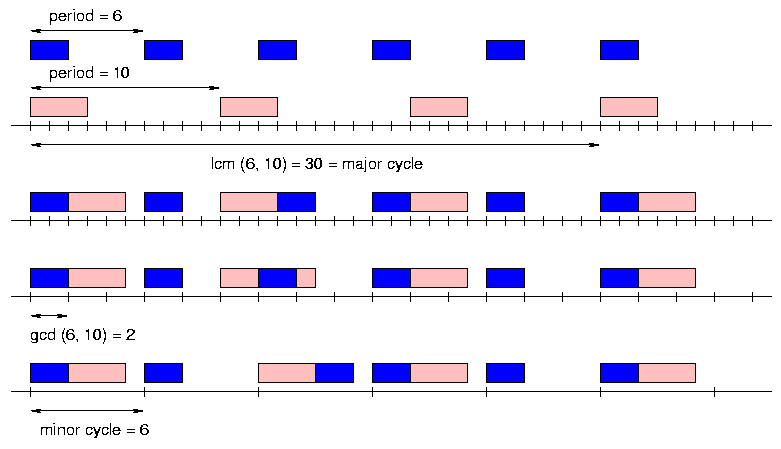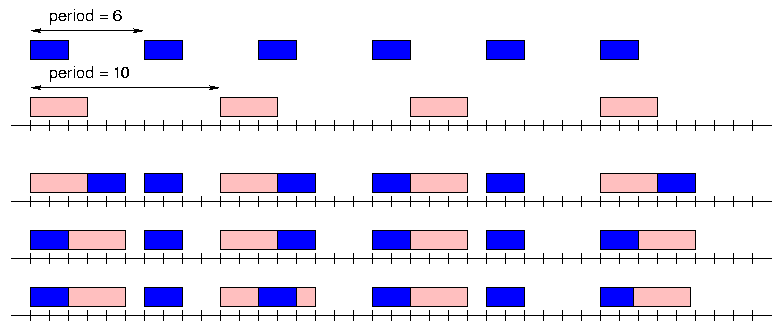Introduction to Real-Time Scheduling
Three Practical Approaches to Real-Time Scheduling
- clock-driven
- weighted round-robin
- priority-driven
Warning: Chapter 4 of the text presents scheduling
concepts initially in terms of scheduling a single batch of jobs,
rather than the periodic or other recurring arrival patterns that
are typical of real-time systems. That is, the text glosses over
the distinction between a situation with a fixed finite set of
jobs and situations where there is an unbounded stream of jobs.
The algorithms generaly can be applied in both kinds of context,
but the schedulability analysis may be different.
Clock-Driven Scheduling Overview
- a schedule of jobs is computed off-line
- all scheduling decisions are made a priori
- schedule is static, finite
(but generally is applied cyclically)
- the run-time scheduler is driven by a hardware timer
and simply follows this schedule
- there is minimal runtime overhead
- behavior is completely predictable
- some variation can be accomodated using multiple tables
which apply to different operational modes of the system
Examples of Static Scheduling

This is just an introduction to the idea of static scheduling.
Later in the courses we will look deeper into the art of building
a static schedule, and its advantages and disadvantages, if there
is time.
Weighted RR Scheduling Overview
- job executions are interleaved
- jobs are kept on a FIFO queue
- when the top job has used one time slice it goes around
to the end of the queue
- can approximate
n processors
- time slices may vary
simulating processors of different speeds
- delays completion of all jobs
- can be good for pipelined jobs
Examples of Round-Robin Scheduling

Priority-Driven Scheduling Overview
- top-priority job gets to run until completion
- processor is never idle if jobs are waiting
- can be preemptive or non-preemptive
- can be applied to single or multiple processors
This is also known as list, greedy, and work-conserving
scheduling.
Examples of Priority-Driven Scheduling

Precedence Constraints, Effective Release Times & Deadlines
- effective release time
ri of job i =
- ri if i has no
predecessors
- max{rj + e-j | j is
predecessor of i } otherwise
- effective deadline Di of job i =
- Di, if i has no successors
- min{Dj -
e+j | j is successor of
i }, otherwise
Note: The notation x here is intended as an HTML approximation to
the symbol x with a horizontal line over it that is used
in Jane Liu's text.
These definitions are helpful in reducing need for explicit
consideration of precedence constraints.
Static vs. Dynamic Processor Assignment
Dynamic assignment generally results in
intractable validation problems.
These problems will be discussed in more detail later in the course.
© 1998, 2003, 2006 T. P. Baker.
$Id: introscheduling.html,v 1.2 2008/08/25 11:18:48 baker Exp baker $ |


